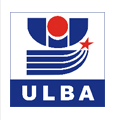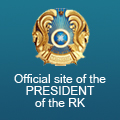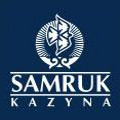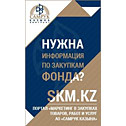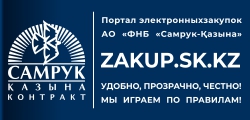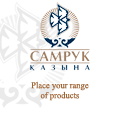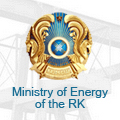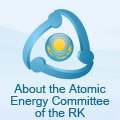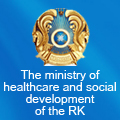History JSC UMP
Chronology of Primary Events
1949 – Stocking of the first product as Thorium Oxalate. A year of Ulba Metallurgical Plant establishment
1951 – Start of 20% HF acid production
1952 – Establishment of Tantalum Operations Division
1954 – Establishment of Uranium Operations Division
1956 – Establishment of Beryllium Operations Division
1972 – Establishment of the fabrication of accessories, end parts and components for nuclear power industry
1974 – Establishment of superconducting materials fabrication
1992 – Establishment of the fabrication of metal coins and awards of the Republic of Kazakhstan
1997 – Affiliation of Ulba Metallurgical Plant to NAC Kazatomprom
1998 – Certification of the quality management system in compliance with ISO 9002
1999 – Start of the Karadzhal fluorite concentrate deposit development
2003 – Certification of the environment management system in compliance with ISO 14001
2003 – Certification of the quality management system in compliance with DIN EN ISO 9001:2000
2005 – Development and adoption at Ulba Metallurgical Plant of the technology of highly enriched uranium down-blending to low enriched uranium to be further used as NPP fuel within the framework of the nuclear weapons non-proliferation project
2006 – Putting into operation of the fluorite ore concentration plant at Kurchatov
2011 – The 52nd TIC General Assembly for Tantalum and Niobium studies (Almaty, Ust-Kamenogorsk) was held
History of Uranium Production
1952 – Board of Ministers of Soviet Union decided to create the Uranium raw material conversion production at Ulba Metallurgical Plant
1953 – Commissioning of shop complex for natural Uranium concentrates conversion into U3O8
1954 – Industrial processing of Uranium concentrates and U3O8 production started
1958-1963 – Modernization of Uranium production workshops, development of Uranium tetrafluoride production from natural raw material and by-products
1967 – Creation of heat-generating elements fuel cores production for transport reactors based on Uranium-Beryllium compound
1973 – Development of Uranium dioxide of nuclear purity ceramic grade of low enrichments (1.6-4.4% U235) from Uranium hexafluoride
1978 – Ulba Metallurgical Plant became the first in the Soviet Union plant beginning the serial production of fuel pellets from Uranium hexafluoride for a new generation reactors VVER-1000
1981 – Production of powders and fuel pellets for RBMK-100 from reprocessed raw material (uranyl nitrate hensahydrate fusion) was set up
1985 – Extraction-free production of powders and pellets was set up
1994 – Development and implementation of process technology for fuel pellets production with burn-out absorber additions as Gadolinium oxide for VVER-1000 reactors
1995 – First verification of Uranium was performed according to IAEA regulations. IAEA Safeguards were implemented.
1997 – Plasma conversion of Uranium Hexafluoride was introduced for production of Uranium Dioxide powders.
1998 – First in Kazakhstan certification of Quality Assurance System of Uranium production for compliance with ISO-9002.
– An area of Uranium Hexafluoride decanting and homogenization was established and put into operation
1999 – Production of natural U3O8 from chemical concentrates of Kazakhstani deposits was set up
2000 – Production of fuel pellets with burn-out absorber additions as Erbium oxide production for RBMK-1000 reactors was mastered.
2001 – Production of fuel pellets of the reprocessed feed material for WWER reactors was mastered.
2001 – Process technology of converting Uranium-Gadolinium ash and scrap was developed and put into operation to produce Uranium of ceramic grade and nuclear purity.
2003 – Production technology of producing Uranium oxide as U3O8 of natural Uranium as chemical concentrates as for direct fluoridizing was introduced.
2004 – Area for fuel elements fuel reprocessing with highly enriched Uranium was set up.
2010 – Uranium production was certified as a supplier of Uranium Dioxide powder produced from Uranium Hexafluoride for NFI, Japan; – Production of pellets for AFA 3G fuel assemblies was certified by AREVA NP, France and СJNF, China.
2012 – Uranium Production Division was certified as Uranium dioxide powder supplier for Westinghouse, Sweden
History of Beryllium Production
1951 – Start-up of experimental shop division for (BeOH)2 and BeO production
1952 – First (BeOH)2 and BeO samples were produced
1955 – Construction of Beryllium metal cast production started
1956 –Commissioning of pure BeO production workshop
1958 – Partial commissioning of workshop 6 (ceramic production)
1961 – Beryllium metal production workshop construction completed
1963 – Creation of Be metal products production workshop
1966 – First metal produced by powder metallurgy method
1971 – Powder production workshop commissioned (Building 662)
1973 – Beryllium under pressure processing workshop commissioned (Building 602)
1990 – Full conservation of the Beryllium production started
2000 – Beryllium metal production started-up
Quality assurance system at the Beryllium production was certified in accordance with ISO-9002
2001 – Hydrometallurgy production for technical grade (BeOH)2 restored Creation of Beryllium Copper production.
2002 – BerylliUM LLP subsidiary was found in Moscow in order to provide Beryllium Products to Russian customers with uninterrupted and immediate supply
2004 – Ulba-China Co., Ltd. subsidiary was found in Shanghai in order to sale Beryllium Products on the markets of China and South-East Asia countries
2007 – Chinese-Kazakhstani company Yingtan Ulba Shine Metal Materials Co., Ltd. manufacturing rolled products of Beryllium bronze was found
2011-2012 – Projects on supply of beryllium reflector for neutron source were implemented as per the orders of:
– State Scientific Centre Science and Research Institute of Nuclear Reactors (Russia);
– POLATOM for reactor Maria (Poland);
– Japan Atomic Energy Agency JAEA);
– Institute of Nuclear Physics of Academy of Sciences of the Republic of Uzbekistan, reactor BBP-CM;
– Kharkov Institute of Physics and Technology (Ukraine);
– Tomsk Polytechnic University, research reactor IRT-Т (Russia). 2012 – Tolling Contract for processing Beryllium hydroxide of Materion Corp. (USA)
History of Tantalum Production
1951 – The first products output - Potassium Fluorotantalate
1952 – Potassium Niobate production was set up
1959 – Beginning of works on Tantalum powders production by Sodium thermic method
1960 – Beginning of Tantalum powder production by Sodium reduction from Potassium Fluorotantalate mastering the extractive technology of digestion and separation of Tantalum and Niobium
1961 – Implementation of extractive technology of Tantalum digestion
– Start of mastering ingot production by vacuum-arc melting
– First Tantalum metal moulds were produced, mastering of sheet rolling
– Start of Tantalum capacitor powders manufacturing for production of electrolytic capacitors
1964 – Production of the first Tantalum ingots of high purity by electron-beam melting method, trial roll lots production
1965 – Start of Tantalum wire production
1966 – Commissioning of capacitor powders de-hydrating facility
1967 – Creation of foil production workshop and start of mastering Tantalum foil production technology for capacitors
1980 – Creation of experimental facility for Tantalum recovery (LUV-1) and in 1982 experimental and commercial facility D-450 for production of powders for high voltage capacitors was set up
1997 – Creation of Niobium Hydroxide, Niobium Pentoxide and Ferroniobium production
2000 – Two types of Tantalum products, Tantalum powders of capacitor grade of fragment type and Low Si Ferroniobium were awarded with diplomas and golden medals of the Kazakhstan Republic Exhibition Astana-Expo-2000
2001 – Quality system of the Tantalum production was certified in accordance with international standard ISO-9002.
2001 – The first trial samples of capacitor grade Tantalum powder with 32,000CV/g were produced
2002 – Commercial production of Niobium and its alloys for metallurgy and electronics needs was started
2002 – New types of products such as Yttrium refined Tantalum, TaW, NbZr and NbTi were produced
2003 – Environmental Management System was certified for compliance with ISO 14001:1996
2003 – Quality Management System was certified for compliance with ISO 9001:2000
2003 – Production of 250mm Tantalum ingot and 99.97% Ta content started
2008 – Organization of NbAl master alloy production
2011- Production of Ni ingots was established that allowed closing production cycle from processing of raw material to manufacturing of end Niobium products
2011 – The 52th TIC General Assembly was held in Kazakhstan. The participants headed by TIC Chairman visited Tantalum Production Division of Ulba Metallurgical Plant JSC where they had a chance to see full production cycle from processing the raw material up to manufacturing finished products.
2011 – Ulba’s Tantalum Conflict-Free Smelter audit was conducted in order to confirm non-use of conflict African raw material and active social commitments of the company by Electronic Industry Citizenship Coalition, Incorporated (EICC). A “non-conflict processor” certificate was issued by EICC. Availability of such certificate is a requirement of products consumers. The certificate was confirmed in 2012. 2012 – Capacitor powders of 30, 40, and 50 kCV group were certified by customers. Delivery contract was signed. Commercial production of lots started.
History of Hydrofluoric Acid Production
1951 – Finished product output: 20% HF acid.
1952 – The workshop was targeted at production of 40% HF acid with high purity for the needs of Uranium production.
1960-1963 – Transfer of furnaces to electrical heating
1972-1974 – The first line of new building 30A was commissioned.
1999 – License for experimental mining of the Karadzhal fluorspar deposit (East-Kazakhstan region). The problem of supplying HF production with raw material was solved.
2000 – Fluorspar processing complex was put into operation at Trial Lead Plant.
2001 – The problem of utilization of solid wastes was solved. 2003 – Hydrofluoric acid production was switched over to Kazakhstani fluorspar of the Karadzhal deposit
History of Machine Building (Mashzavod LLP)
1972 – By virtue of the Medium Machinery Ministry decision production of stop valves, end items and accessories production for atomic power industry was set up at UMP
1976 – The APS accessories production was transformed into an independent division
1986 – Within the frame of conversion production of fast moving consumer goods was set up
1991 – Workshop was transformed into a Machine Building Plant being a part of UMP JSC
1996 – Machine Building Plant was transformed into Mashzavod LLP
